40. Belaying-pin opened to serve as a button; these are used where it is necessary to stop or check velocity.
41. Chain knot, or fastening.
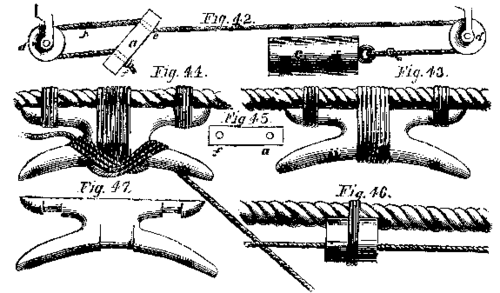
42. Variable or regulating lashing. By laying the piece, a f, horizontally, it can be slipped along the rope, b; by raising or lowering this, we shall raise or depress the weight, c, the cord, b, running over the two pulleys, d, from the piece, a f, in the direction shown in the figure. The friction of the cord, b, passing through the hole, e, sufficiently fixes the piece, a f, and holds the weight, c, securely.
43. Cleet, with three ties.
44. Cleet, showing the mode of belaying the cord.
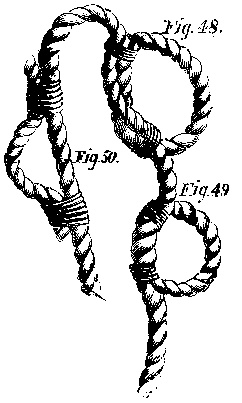
45. The piece, a f, of No. 42.
46. Fair leader.
47. Cleet to be fixed to a stay.
48. Loop for slipping other lines.
49. A "bend" which is only used for fear of the stoppers snapping.
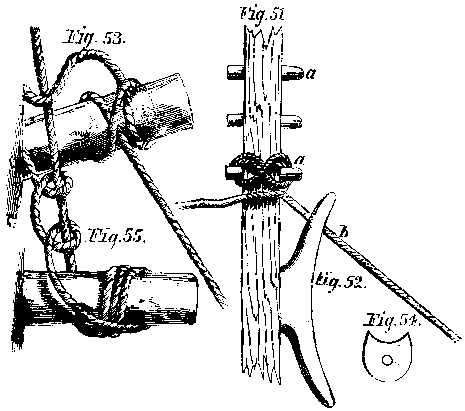
50. Bastard loop, made on the end of the rope, and whipped with yarns.
51. Tie to pins: a, the pin; b, small cords fixed by a cross tie.
52. Cleet, fixed to the "rail," either with screws or nails, to which the lines are belayed.
53. Waterman's knot.
54. Fair leader.

55. Tie, or bend to pier.
56. Simple fastening to tie.
57. Fastening by a loop. This can be tied or untied without loosening the loop itself. It is made by following, towards the longer loop, the direction as numbered 1, 2, 3, 4, 5, and is terminated by the loop, 6, 7, 6, finally passing it over the head of the post, A. This knot holds itself, the turns being in opposite directions. To untie it, we slack the turns of the cable sufficiently to again pass the loop, 6, 7, 6, over the post, A, and turn the ends in the contrary direction to that in which they were made (as 5, 4, 3, 2, 1).


58. Iron "shell," in two views.
59 and 60. "Wedding" knots; a b, eyelets; c d, the join; e, the fastening.
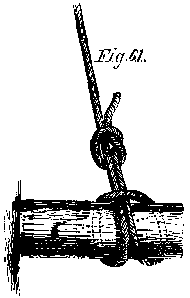
61. Lark's-head fastening to running knot.

62. A round turn; the cord, a, is passed through the bight of the cord, b, over the button, c, where it is secured by an ordinary knot.
63. Belaying-pin splice. The cord, b, "stops" the pin, e, its end being spliced upon itself, and "served" with yarn; this rope, with its pin, is passed through the spliced eye, f of the line, g.

64. Round button.

65. Joint by a spherical shell, each loop, a and b, being made by ties and splices, and surrounding the shell, c.
66. Belaying-pin, shown separately, before being stoppered.

67. Fastening to shears.
68. Square mooring. When the cable is round the post, A, and the piece, c, without being crossed, it lays in the section 1, 2, 3, 4, 5, 6, 7, and the end is fastened by tying.
69. Wooden shell in section.

70. Crossed fastening. The turns of the cable, passing in front of the post, B, are crossed at the back of C, in the direction 1, 2, 3, 4, 5, 6, 7, 8, the end, 8, being secured to the cable.
71. Wooden shell.
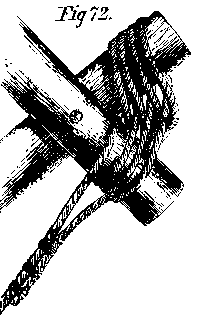
72. Double-chain fastening.

73. Lashing for "ram" block, or "dead-eye." The ram blocks, a and b, are strapped by the cords, e, which hold them; the small lanyards, d, pass through the holes to make the connection, and as they are tightened give the requisite tension to the cordage; the ends are fastened to the main rope. Usually one of these dead-eyes is held by an iron strap to the point where it is required to fix and strain the cordage, which is ordinarily a shroud.
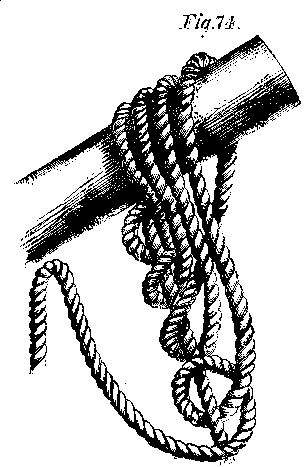
74. Chain fastening.

1'. Simple band, showing the upper side.
2'. The same, showing the under side and the knot.
3'. Tie, with crossed ends, commenced; a turn is taken under the strands, to hold the ends of the cord.
4'. The same, completed.
5'. Bend with crossed strands, commenced, the one end being looped over the other.
6'. The same, completed.
7'. Necklace tie, seen on the upper side.
8'. The same, seen underneath. The greater the strain on the cords, the tighter the knot becomes.
9' and 10' are similar splices to 7' and 8' with slight modifications.
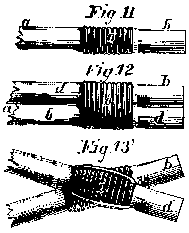
11' shows the commencement of 13', the legs in elevation; 12' being a front view. An ordinary band, made by several turns of a small rope, is lapped round them and hauled taut, and then interlaced at the ends. This done, the legs are shifted into the shape of a St. Andrew's cross. Thus the lashing is tightened, and, for further security, we pass the line several times over the tie and between the spars, knotting the ends.
13'. Portuguese knot. This is a lashing for shear legs, and must be tight enough to prevent the spars slipping on each other; the crossing of the two legs gives a means of securing the knot.
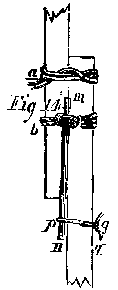
14'. For binding timbers; a, knot commenced. Take several turns round the timbers, and fasten the ends by passing them under the turns; b, knot completed. The end of a round stick, m n, termed a packing stick, should be passed under the knob, the cord being slack enough to allow of this. By turning the stick, the turns can be tightened to any extent; when tight, we fasten the longer arm of the lever to some fixed point, by a rope, p q, so that it cannot fly back. Care must be taken not to turn the stick too far, or the rope may be broken. As the timber dries and shrinks, the lever may be used to make all taut again.